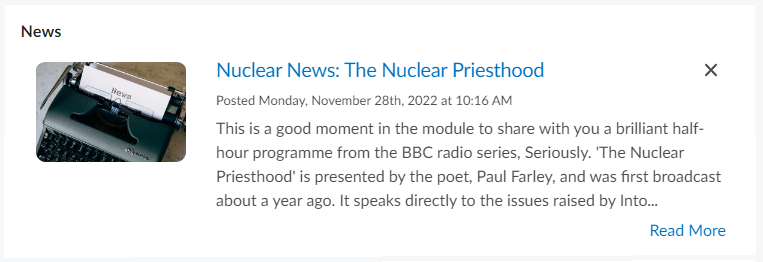The news or announcements feed within an online learning environment can serve as a key strand in enhancing the dialogue between instructor and students throughout a module, increasing what we’ve explored in the past as a sense of “presence”. News posts can be used simply to remind students of upcoming events and assessments, though many of the colleagues we support also use them to draw attention to topical news stories that are relevant to the subject content. Recently, however, I spoke to Dan Cordle (Associate Professor in the Department of English, Linguistics and Philosophy) about the ways he uses the news feed to engage students on his Nuclear Literature module. I had seen that his news posts were thoughtful, engaging and designed to fuel interest in the subject matter, but it was only through speaking to him that I understood that they have purpose beyond that. They also prompt students to delve more deeply into the literature, help to signal the scope of the learning in his module, and form part of his efforts to build a community of learners around the subject of nuclear literature.
Categorising the news
Dan is first to point out that his particular use of news items to engage students is not technologically complex. Instead, what marks out his approach, besides the informal and personal style of writing, is his decision to categorise his news posts into three different types:
- “Nuclear news” items pick up on the themes of the module across different media and cultural artefacts;
- “Nuclear literature scholarship” items pick out scholars from the resource list (not covered in the core module activities) to throw a spotlight on their work;
- General announcements are about practical aspects of the course, including the release of formative feedback and the results of polls students have taken.
When students see these posts in their main online learning feed, they know immediately from the title of the news item and accompanying image what type of news it is, allowing them to better decide about whether or not they want to read more at that moment.
Sparking imagination and fostering a learning community

Dan selects and writes his “Nuclear News” items to spark the imagination of his students and to indicate his enthusiasm for the subject. The sort of thing he might cover ranges from radio plays, film reviews, and exhibitions to moments in video games – whatever comes up that demonstrates the broad influence of nuclear culture and literature on how we experience nuclear technology. It is, of course, time consuming to write these posts. However, Dan explains that this is his way of communicating to students that he is actively looking after their online learning environment and giving them a reason to return to the online materials regularly. “After all,” he says, “if we’re not interested, why should they be?”
Dan also encourages the students to submit topics for the “Nuclear news” to him and he posts them, giving an avenue for students to influence the learning environment and become active participants in their learning community. Even in the practical news updates categories, Dan invites feedback from students on questions of how the module is being run, offering email, face-to-face, and even polling tools as potential communication methods, making the online learning experience into a dialogue between himself and his students.
Encouraging deeper engagement and signalling the scope of learning
The newest category he has added, “Nuclear literature scholarship,” is designed to spotlight selected scholars from the extensive resource list that students might otherwise miss. Dan wanted to try this new category out particularly at the time of year when students will be building up their own bibliographies and hopes that it will provide some “landmarks” of the literature to navigate by, encouraging students to read more deeply.

At the same time, Dan emphasises that there are nuclear-related topics that he resists posting on, such as topical news stories about geopolitical nuclear instability, since the focus of the module does not lie there. In short, his news posts reflect and indicate the scope of the subject content, drawing students away from generalised commentary on nuclear policy and toward sophisticated engagement with nuclear culture.
There currently isn’t any way to track how many students are accessing the news items, but Dan has noticed that in module evaluation surveys his students comment that the online learning environment is kept up to date and new things are continually being added. This feedback suggests that the sense of care about the subject and the online learning environment coming through in his news items is being noticed by the students. Studies looking at how online communications from instructors influence student motivation and behaviour suggest that demonstrating “care” can be a “significant motivator” to students (Leners and Sitzman, 2006).
It’s perhaps easy to overlook the news feed, which might be considered a relatively small part of an overall approach to learning and teaching. However, the way Dan uses them allows him to communicate a lot beyond what he is writing: his enthusiasm for the subject, that his students’ input into the module is welcomed, and that there is a rich scholarship and culture around nuclear literature beyond what is directly studied.
References
Leners, D.W., and Sitzman, K., 2006. Graduate student perceptions: Feeling the passion of CARING online. Nursing Education Perspectives; Nurs Educ Perspect, 27 (6), 315-319.
